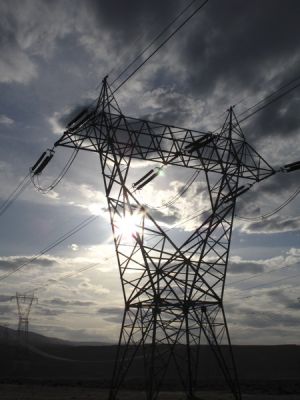Philip W. Rendina was a junior currently pursuing a Bachelor's Degree in Electrical Engineering at Rose-Hulman Institute of Technology in Terre Haute, Indiana in the fall of 2003. He enjoys spending leisure time with family and friends, listening to music, photography, and video editing.
In order to bring high-speed internet to areas where developing a traditional broadband infrastructure would be cost prohibitive, engineers have recently begun working on developing techniques for delivering broadband internet signals over the existing power supply grid. By using an entirely different frequency range, power lines can carry traditional AC power and data signals simultaneously. Although modifications to the current infrastructure are necessary to deliver the signals and minimize interference, the technology looks promising, as tests have yielded results comparable to other methods of broadband delivery.
Introduction
Imagine living in a rural area of Wyoming and desiring to connect to the internet. Most likely, your only option is a dial-up connection at less than 56K speeds. Since there are relatively few subscribers in this area, cable and DSL (digital subscription lines) broadband internet service providers choose not to offer service, instead opting to focus on larger markets (Fig. 1).
With the recent realization that high speed broadband internet signals can be carried over the power supply grid, public utility companies have developed and are now implementing such a service, PLC (power line communication). Because the utility companies have existing infrastructure in place to transmit BPL (broadband over power lines) signals, they have a significant advantage over cable and DSL providers: whereas traditional broadband providers need to set up an entire infrastructure to tap into a market, utility companies need only to make slight modifications to the power supply grid to allow transmission. Yet, these slight modifications have proven to be very problematic.
Although implementation of BPL is not without its problems, the potential benefits of such technology have driven engineers to develop various techniques to overcome these problems. Once fully operational and problem-free PLC systems implementing BPL are in place, everyone who has an electrical outlet will be able to have a high-speed internet connection.
The Power Supply Grid and How It Works
In power plants across the United States, three-phase AC (alternating current) power is generated at 60 Hz. Three-phase power refers to the three 120 degree phase shifts in the AC power sine wave between 0 and 360 degrees [1]. After generation, the power leaves the plant and travels a short distance to a transmission substation where the voltage component of the power is increased to anywhere from 36 to 300 kV to reduce the current, thereby reducing overall loss in the power lines. Leaving the transmission substation, the power is transmitted up to a distance of 300 miles on HV (high voltage) lines until reaching a power substation. At the power substation, the voltage is stepped down by transformers to a voltage in the range of 1 to 36 kV and also “split” by buses to be delivered along multiple MV (medium voltage) lines into cities and towns. Once in the city or town the voltage is again stepped-down by MV/LV (low voltage) pole transformers to 120 V. Taps are used to filter out two of the three phases of power that are to be delivered to the customer. At the customer’s residence, the two phases are fed to a panel board that acts as a bus bar. All devices in the customer’s residence utilize only one phase of power except for water heaters and similar devices, which use both phases to deliver 240 V [2] (Fig. 2).
Modifying the Power Supply Grid for BPL
In order to retrofit the existing power supply grid, networking hardware must be installed at various points along the power transmission path. In order to manage this process, the four main areas of interest for hardware placement are referred to as the S,R,X, and GW nodes.
The S-node occurs at the power substation where the existing “backhaul” data network, which is the internet, is merged with the power lines. This merger is possible because the data signal of the internet is in the megahertz range of the radio frequency spectrum and the power line carries power at 60Hz, thus allowing the two signals to coexist on one line without interfering. After it is merged onto the power lines, the signal travels from the substation down various MV lines. While en route, due to the nature of the merged signals, the data signal must be reinforced by amplifiers at the R-Node. From the R-Node, the merged signals travel to the X-Node which is located at the MV/LV pole transformer.
It is at this point where the “last mile” problems arise because transmission past the MV/LV pole transformer and into the residence has been the most problematic portion of transmission. Since the power grid was initially designed to only transmit power signals, the MV/LV transformers act as low-pass filters letting the 60Hz power signal through while blocking the internet signal which is at a higher frequency. There is a solution: couplers, which act as high-pass filters, allow frequencies in the range of 2 to 50 MHz through. Couplers must be added to the MV/LV lines so the internet signal can bypass the transformer and then “hop” back on the low voltage lines toward the destination. At the residence, the GW-node begins with the PLC network interface, or modem. Depending on the number of users, the network could be bridged for cost-effectiveness if usage is low, or if usage increases, routers and switches can be implemented to ensure quality service. As for the PLC modem, OFDM (orthogonal frequency-division multiplexing) has been the most successful coding modulation used with DSL and most likely will continue with BPL. OFDM operates in the same way as a digital radio tuner: by being able to precisely pick out a specific, strong signaled radio station frequency from the broad and noisy 88 to 107 MHz radio frequency spectrum that contains many radio stations. In BPL applications, the modem applies OFDM to a spectrum ranging from 2.46 to 38 MHz, while providing physical and link layer data encryption [3].
Problematic Aspects of BPL
Although PLC systems have been designed and tested on small markets, many problems with the systems have halted the nationwide growth of BPL. One obvious problem is that the wires that carry the signals were designed to transmit power signals at 60Hz, not broadband internet signals in the megahertz range. Consequently, the unshielded cables transmitting the broadband signal will act as antennas interfering with other devices and picking up interference itself. Unfortunately, this interference occurs in the same radio frequency spectrum in which ham radios, FM (frequency modulated) radio, and wireless communication signals operate [2]. Consequently, on October 14, 2004, the Federal Communications Commission(FCC) realized the potentially enormous impact of BPL on the American people and issued a change to the Part 15 rules allowing BPL to operate safely in specific ranges of the RF (radio frequency) spectrum [4]. Part 15 of the FCC rules states that all devices must operate on an unlicensed basis and share the RF spectrum with licensed services. Furthermore, these devices must not interfere with licensed services and must accept all interference from such services. With this rule change, BPL is considered an unlicensed service so it must comply with the Part 15 rule. BPL will be able to comply by determining what licensed services are in operation, such as radio services, and at what frequencies they are broadcasting so as to avoid these frequencies [5]. In addition, certain “excluded frequency bands” are defined by the new rule change so BPL signals do not interfere with aeronautical and aircraft communications [4].
A BPL Trial and Its Results
So now that the process of delivering BPL is understood, an actual field test on one such implemented BPL system can be analyzed for its effectiveness. In one specific trial conducted in New York, a BPL signal was distributed along MV lines powering residential to medium industrial users. Before beginning this trial period, the power grid was surveyed and data was collected to determine the correct placement of repeaters and couplers for optimum performance. Four different locations were then chosen to have their networking performance analyzed and monitored. Using FTP (file transfer protocol) the bandwidth throughput tests of the MV lines and the bandwidth received by the customers yielded impressive results. Rates of 10 to16 Mbps were achieved over the MV lines and rates of 3 to 7 Mbps were provided at the customer residences.
Network Monitoring with PLC
After modifying an existing power grid to be capable of delivering BPL, not only can high speed internet signals be transmitted, but also information about the status of the network. With the installation of PLC network devices that employ SNMP (Simple Network Management Protocol), information about the status of the network and data throughput rates can be remotely monitored by the utility company. In this way, the utility company will always know what is or is not working properly, without the need for field technicians to physically examine the site under question. Additionally, remote metering would reduce the dependence of the utility company on field technicians who would have to physically inspect the site under question. This would also result in improved customer service in the case of a failure, because the company would be aware of a failure at the immediate moment of failure, thereby alleviating its dependency on customer complaints to alert them of the failure [3].
In-home PLC and the Possibilities
So far the advantages of a PLC network delivering BPL have been discussed on a macroscopic scale, but what are the effects of PLC in the home, besides a fast internet connection? In an effort to make PLC networking devices more mainstream and recognized, Panasonic, RadioShack, Sharp, Comcast, Intellon and others have teamed up to create the HomePlug Powerline Alliance, which develops products that utilize in-home wiring to setup home-based personal networks using the latest HomePlug 1.0 standard [6]. These products include modems, routers, switches, and other standard network devices that either work with existing cable or DSL connections or with a full end to end PLC network. With the eventuality of all home entertainment systems integrating PLC technology, the transfer of video, music and general data between devices will become an afterthought.
Conclusion
At the moment, BPL seems to be a very promising technology that is expanding every day, especially with the development of products that can be purchased right now that can create an in-home PLC to transmit BPL. With such an explosive growth in PLC devices due to contributions from the HomePlug Powerline Alliance and now the FCC via their rules change, utility companies are now beginning to expand and implement BPL services through field tests of their PLC network. Since BPL’s impact on everyday society will be so ground-breaking, expect to see BPL coming to more and more towns and cities in the coming years.
References
[1] Marshall Brain. 2003. “How Power Grids Work.” HowStuffWorks. Internet: http://science.howstuffworks.com/power.htm, Oct. 2004.
[2] M. F. Gebhardt and K. Dostert Weinmann. “Physical and Regulatory Constraints for Communication over the Power Supply Grid.” IEEE Communications Magazine, vol. 41, pp. 84-90, 2003.
[3] G. Jee and Y. R. Das Rao. “Demonstration of the Technical Viability of PLC Systems on Medium- and Low-Voltage Lines in the United States.” Cern. IEEE Communications Magazine vol. 41, pp. 108-112, 2003.
[4] Federal Communications Commission. “FCC Adopts Rules for Broadband Over Power Lines To License Competition and Promote Broadband Service To All Americans.” 14 October 2004.
[5] G. Lapin. “Will Changes to Part 15 of the FCC Rules & Regulations Encourage Innovation?” Internet: http://ftp.fcc.gov/oet/tac/Part_15_Survey_12_4_02.ppt, 2002 [Oct. 2004].
[6] HomePlug Powerline Alliance. Internet: http://www.homeplug.com/members/, [Oct 2004].
[7] N. A. Pavlidou, Han Vinck, J. Yazdani, and B. Honary. “Power Line Communications: State of the Art and Future Trends.” IEEE Communications Magazine, vol 41, pp. 34-40, 2003.





